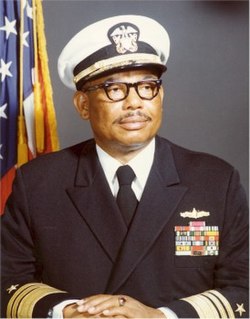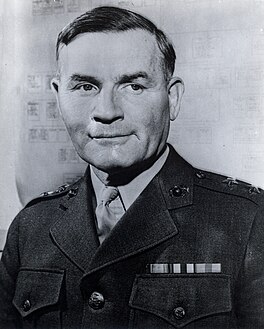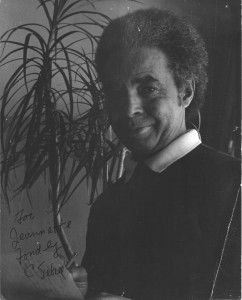
The Lewis and Clark class of dry cargo ship is a class of 14 underway replenishment vessels operated by the United States Navy's Military Sealift Command. The ships in the class are named after famous American explorers and pioneers.

Samuel Lee Gravely Jr. was a United States Navy officer. He was the first African American in the U.S. Navy to serve aboard a fighting ship as an officer, the first to command a Navy ship, the first fleet commander, and the first to become a flag officer, retiring as a vice admiral.

Lake Pend Oreille in the northern Idaho Panhandle is the largest lake in the U.S. state of Idaho and the 38th-largest lake by area in the United States, with a surface area of 148 square miles (380 km2). It is 43 miles (69 km) long, and 1,150 feet (350 m) deep in some regions, making it the fifth-deepest in the nation. The lake is fed by the Clark Fork River and the Pack River, and drains into the Pend Oreille River, as well as subsurfacely into the Spokane Valley–Rathdrum Prairie Aquifer. It is surrounded by national forests and a few small towns, with the largest population on the lake at Sandpoint. The majority of the shoreline is non-populated and all but the southern tip of the lake is in Bonner County. The southern tip is in Kootenai County and is home to Farragut State Park, formerly the Farragut Naval Training Station during World War II, of which a small part is still active and conducts U.S. Navy acoustic underwater submarine research.

Concord Naval Weapons Station was a military base established in 1942 north of the city of Concord, California at the shore of the Sacramento River where it widens into Suisun Bay. The station functioned as a World War II armament storage depot, supplying ships at Port Chicago. During World War II it also had a Naval Outlying Field at the southern edge of the base. It ceased being an operating airfield after World War II. During the Korean War, the Vietnam War and the Gulf War, Concord NWS processed and shipped thousands of tons of materiel out across the Pacific Ocean.

Major General Charles Dodson Barrett was the first commanding general of the 3rd Marine Division. He died while on duty in the South Pacific, 8 October 1943. He was posthumously awarded the Distinguished Service Medal in recognition of his outstanding service during World War II. Camp Barrett, home of The Basic School at Marine Corps Base Quantico is named after him.

The Golden Thirteen were the thirteen African American enlisted men who became the first African American commissioned and warrant officers in the United States Navy.

Vice Admiral Baron Tomoshige Samejima, was an admiral in the Imperial Japanese Navy during World War II.

Patricia Ann Tracey is a retired United States naval officer and the first women to be promoted to the rank of vice admiral in the United States Navy. She held the positions of chief of naval education and training (CNET) (1996–98), Deputy Assistant Secretary of Defense for Military Personnel Policy (1998–2001), and director of navy staff from 2001 until the time of her retirement on October 1, 2004. At that time, she was also the all-time senior-ranking female officer in the United States military.
Oscar Henry Dodson was a rear admiral in the United States Navy, who served during World War II. After retiring from the Navy, Dodson was appointed Assistant Professor of History at the University of Illinois. He was also a noted numismatist and served as president of the American Numismatic Association (ANA) from 1957-1961.

Carrier Air Wing Six (CVW-6) was a United States Navy aircraft carrier air wing whose operational history spans from the middle of World War II to the end of the Cold War. Established in 1943 as Carrier Air Group Seventeen (CVG-17), it would be re-designated several times during its establishment, including Carrier Air Group Six (CVG-6) as the second unit to be so designated. The first Carrier Air Group Six served for just over two years during World War II, but drew on the history of the Enterprise Air Group established in 1938 and active in the early battles of the Pacific War, being disestablished after the first year of the conflict. During its time in USS Enterprise (CV-6), it was the Navy's only carrier-based air group to carry out three complete tours of duty during World War II.

The Medical Education and Training Campus (METC) is a United States Department of Defense (DoD) integrated campus under a single university-style administration, with nearly 50 programs of study available to U.S. military enlisted students and a small number of foreign military students. METC is located at Joint Base San Antonio on Fort Sam Houston, Texas with a field training site located at Camp Bullis.

Kaede was one of 18 Matsu-class destroyers built for the Imperial Japanese Navy (IJN) during the final stages of World War II. Completed in late 1944, the ship was assigned to convoy escort duties in January 1945. After escorting one convoy to southern China, she joined two other destroyers tasked to evacuate Japanese airmen from the Philippines. En route the ships were attacked by American bombers that badly damaged Kaede. The ship returned to Japan for repairs and was inactive for the rest of the war. She was surrendered to the Allies at the end of the war and used to repatriate Japanese troops until 1947. Mid-year the destroyer was turned over to the Republic of China; renamed Heng Yang she became a training ship and remained in service until the 1960s when she was scrapped.

Thomas Francis Darden Jr. was a U.S. Navy officer who achieved the rank of captain, the commander of a Navy light cruiser during World War II, and was the 37th Governor of American Samoa from July 7, 1949 through February 23, 1951. Darden also served on the staffs of two U.S. Navy admirals during the War in the Pacific: rear admirals Henry Hughes Hough and Thomas L. Sprague.
Robert Sherman "Bob" Halperin, nicknamed "Buck", was an American Star class sailor, and Olympic bronze medalist and Pan American Games gold medalist. He was also a college and National Football League (NFL) football quarterback, one of Chicago's most-decorated World War II heroes, co-founder of Lands' End, and chairman of Commercial Light Company.
Robert Michael "Bob" Sweiger was an American football back who played four seasons in the All-America Football Conference (AAFC) with the New York Yankees and Chicago Hornets. He was drafted by the New York Giants of the National Football League (NFL) in the third round of the 1942 NFL Draft. He played college football at the University of Minnesota and attended Central High School in Minneapolis, Minnesota.

Charles Sebree (1914-1985) was an American painter and playwright best known for his involvement in Chicago's black arts scene of the 1930s and 1940s.

SS Jasper Park was a Park ship freighter, built in 1942. She was sunk by torpedo from German submarine U-177 on 6 July 1943, the first Park ship lost to enemy action. She was completed on 24 September 1942, by the company Davie Shipbuilding in Lauzon, Quebec. Her hull number is 537. Davie Shipbuilding is now called Chantier Davie Canada Inc. The ship was owned by the Park Steamship Company, which was owned by Canada's Federal government. The government had built 400 vessels during World War II. Built as a merchant steamship constructed for Canada’s Merchant Navy in 1944. She was named after Jasper National Park in the Canadian Rockies in the province of Alberta, Canada.














